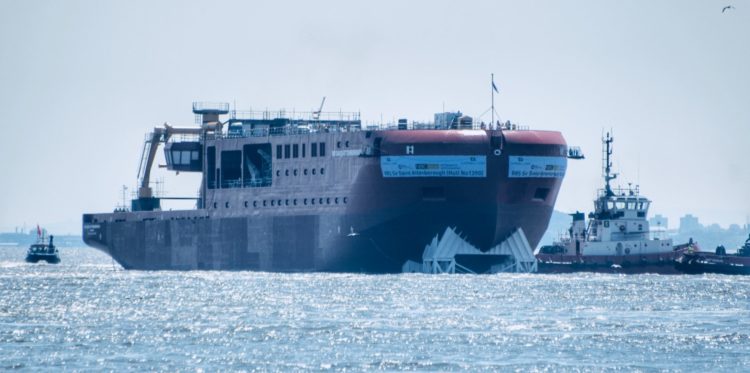
Sir David Attenborough sends £200m polar expedition vessel sliding into the Mersey
With a 10,000-tonne hull, Sir David Attenborough, almost called Boaty McBoatface, went sliding down the slipway at Cammell Laird shipyard and into the river. Tony McDonough reports

Veteran broadcaster Sir David Attenborough has launched the vessel that shares his name into the Mersey – the £200m polar expedition vessel that was almost called Boaty McBoatface.
With a 10,000-tonne hull, Sir David Attenborough went sliding down the slipway at Cammell Laird shipyard in Birkenhead and into the river. The riverbed had been dredged ahead of the Saturday lunchtime launch in case the hull hit the bottom.
With the help of tugs the vessel made its way into the middle of the river before returning to a wet dock at Cammell Laird where, over the next few months, the upper decks and the internal fixtures and fittings will be installed.
Sea trials
Towards the end of the year Sir David Attenborough will be handed over to the British Antarctic Survey when it will undergo sea trials before doing what it was built for – exploring the North and South Poles.
Before pressing the button to send the vessel down the slipway, Sir David said: “Our future will be affected by what people working on this ship will be discovering in years to come… it is the greatest possible honour to be its namesake.
“When 100 years ago this country sent people down to the South Pole, we were the pioneers in exploring the Antarctic. When we did so, I expect the reason we did was the South Pole seemed as far away as it could possibly get to be on this planet.
“Now, 100 years later, we realise that remote place is, in fact, key to the whole understanding of the planet. What goes on down there effects the whole of the Earth in which we live.”
‘Airfix model’
Cammell Laird was chosen to build Sir David Attenborough in 2015 and began work the following year. Described as being like a “giant Airfix model” she was constructed using one million pieces of steel, 30km of piping, 5,000 valves, and 450km of cabling.
She is 125 metres long with a beam of about 24 metres. Her draught will be about 7 metres . Her cruising speed will be 13 knots with a range of 19,000 nautical miles at that speed.

The vessel will also be equipped to carry a helicopter will have a capacity for approximately 900 cubic metres of cargo. Accommodation will be provided for 30 crew and 60 research staff. It will replace existing vessels RRS James Clark and RRS Ernest Shackleton.
Public choice
An online poll to suggest a name for the ship resulted in the name Boaty McBoatface being the overwhelming choice of the public. It was rejected as the name however, one of the vessels remote controlled submersible crafts will bear the name.
Jane Francis, director of the British Antarctic Survey, told BBC News: “We’ve now got a real state-of-the-art ship and so we’ll be able to do a lot more science. We’ll be able to go into more remote areas.
“We’ll be able to do bigger projects; we’ll be able to do a lot more science. We really will be able to do frontier science that we haven’t been able to do in the past.”
